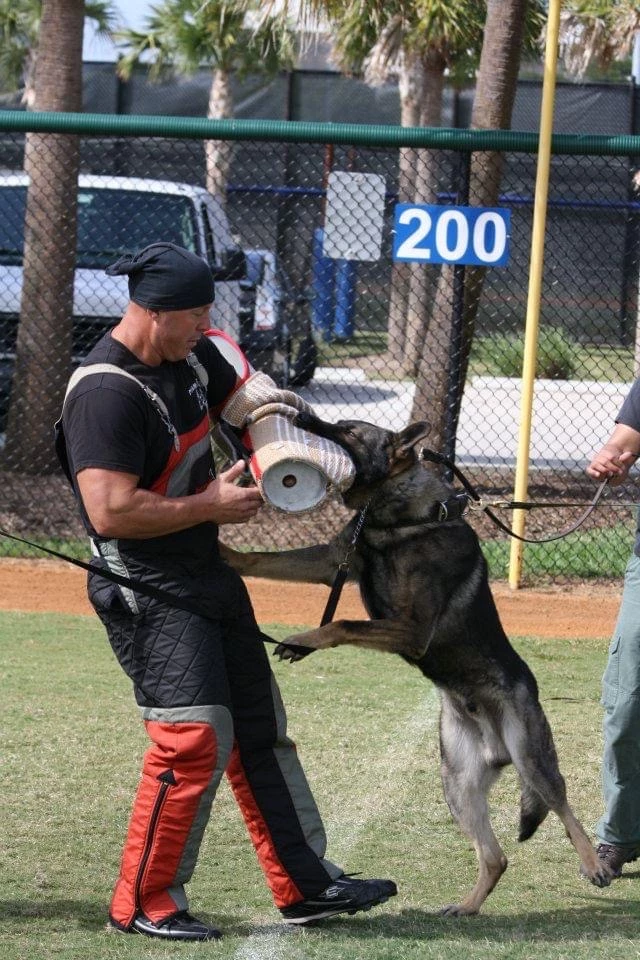Power biting is a combination of training techniques which has been systematically designed to enhance the overall gripping behavior of the dog, while drastically reducing the risk of injury to the dog as well as the decoy. These techniques can be applied to Police service dogs, any of the biting sports, as well as personal protection aggression training. Additional benefits include but are not limited to the following: Enhanced grip depth & pressure, eliminates transfer bites, handler & environmental neutralization, enhanced speed of entry, cardiovascular conditioning, reflex response to pressure and improved targeting. By utilizing the dog’s opposition reflex, ignited by heavy grad bungee lines in conjunction with the decoy facing the dog and driving backwards, we create an activation to drive deeper and fuller into the bite. Through a rhythmic series of releasing and reengaging tension of the bungee by the decoy, the dog’s impulse becomes to drive forward. As this exercise progresses through many repetitions, muscle memory will be instilled.
Once we have an anticipatory behavior, this will give the handler and the decoy the opportunity to implement cues which trigger your dogs’ conditioned response to bite deeper and fuller. This will also trigger the dog to initiate a fight during chaotic settings created by pressure from the decoy and the environment. For example, methodically and non-intrusively being touched by a stick, foot, hand, or any other environmental stressor can be introduced just prior to the anticipated behavior of the dog driving deeper into the bite. Over time, with consistency, what we once knew as “pressure” will become an activation of drive in your dog. As this technique advances, we gradually increase the intensity of the decoy’s opposition and environmental stressors. The utmost caution is given to each dog’s specific needs and genetic capabilities to ensure positive learning occurs with every session.
Decreasing Handler Conflict
If you experience your dog trying to avoid you, or other people around him as he’s being approached while he’s engaged with the decoy or the defendant, there is conflict between you and him. Whether it’s obvious body postures, releasing his bite and repositioning to avoid contact with you, shifting his line of sight from the opposition or losing overall focus during any biting or barking phases, this is problematic for several reasons. In the real world, from a safety standpoint, re-biting allows the opportunity for escape, the possibility of body fluid transfer from the suspect to you during redirected aggression, as well as creating an overall look of the dog being out of control and misbehaving to a Judge and Jury.
In the sport world these reactions of the dog will result in the loss of crucial points. From behavioral perspective, if your dog is in conflict with you, every area of your training and results will be compromised. Your dog must be neutralized to your presence. More importantly, he must feel increased confidence, enhancing his fighting instinct independently and while in close quarter combat with you. Power biting reverses the psychology of your relationship with your K-9 partner, developing a synergistic, team oriented theme to violent encounters during criminal apprehension, as well as guarding phases in sport work.
Implementing Power Biting
This technique is set up as a frontal bite, at a distance. We utilize long, heavy grade bungee lines specifically designed for aggression work in Dog training. The bungee is equipped with heavy clasps on both ends. One for securing the dog and the other allows the bungee to be affixed to permanent objects. Using a bungee which has a gradual progression of tension is ideal. This builds speed, desire and strength during the pursuit prior to entry. This gradual progression is the most important key in greatly reducing the risk of injury during impact.
With the bungee properly stretched and measured prior to being used, we can calculate the exact point where the bite will take place, resulting in zero impact. Over the last few years I have seen an alarming number of dogs having neck, spinal, nerve and rear end injuries, ending careers prematurely. It’s my personal opinion this is being caused by far too many running hits, courage tests, face attacks, flee and escape bites without the use of restraining devices to absorb the dogs energy. The best decoys on the planet can’t completely eliminate the force and violence of impact generated by the dog.
Superior genetics are producing incredibly strong animals. Nutrition, supplementation, cardiovascular conditioning and the progression of modern dog training is putting our Canine athletes on another level of performance. We must take steps to decrease the risk of injury. I can tell you from my personal experience of catching dogs for 20 years, the bungee greatly reduces the risk of injury to the helper, especially the long term wear and tear associated with our craft.
CLIMATING THE DOG TO THE BUNGEE
Dogs must learn to manage the resistance offered by the bungee without excessive strain or creating a negative experience. To ensure this, we hook into the dogs harness and walk him out to the fullest extent of the bungee. By placing our hand on the top strap of the harness, we restrict the bungee from recoiling, maintaining the dogs position. The most affective technique is to conduct a placement bite on the decoy. Once the fullest bite is obtained, the handler releases the harness and allows the dog to experience the full resistance of the bungee. The handler takes a position of about 4-5 feet behind the dog with their hands around the bungee but not with any pressure. They are there to receive the dog should they release the grip prematurely, stopping a violent whiplash effect. Once it is determined the dog is effectively managing the bungee, we begin to move him further and further away from the decoy, allowing him to stretch the bungee with his own drive and effort. Handlers will soon observe an increase in power and dedication to the pursuit of the decoy.
PRONOUNCED GRIPPING BEHAVIOR
The true goal of “Power Biting” is increased depth, pressure and fighting response while biting. As the dog is engaged on the bite, with the bungee resistance maximized, the decoy stops fighting, acts passively and decreases the resistance by moving towards the dog and handler. The moment the bungee slacks, the handler places their hand on the top strap or handle of the harness and gently pushes the dog towards the sleeve or suit. The intense opposition reflex felt from the bungee creates much stronger grip pressure. The slight and quick release of the tension, coupled with the forward push towards the biting surface by the handler ignites the dog to bite fuller and deeper. Immediately after the dog has increased his grip pressure and depth, the decoy rewards this effort with cues the dog has impressed him, injured him and caused more fight in which the dog is always victorious.
At the same time, the decoy reactivates the tension of the bungee to maintain the grip. This exercise is repeated many, many times until we have an anticipated behavior of pronounced gripping. Once this is obtained, through a learning design, we now have the luxury to “name” this behavior, implement cues and triggers provoked by the handler, the decoy and the environment. Once you’ve employed this technique repetitiously, you will observe your dog begin to drive deeper into the bite as you approach, before you can even place your hands on him. Instead of the dog perceiving you as the person who always removes him from the bite, he will feel as though you assist him in the fight. Conflict is eliminated and fighting instincts are increased.
CLIMATING THE DOG TO THE BUNGEE
Dogs must learn to manage the resistance offered by the bungee without excessive strain or creating a negative experience. To ensure this, we hook into the dogs harness and walk him out to the fullest extent of the bungee. By placing our hand on the top strap of the harness, we restrict the bungee from recoiling, maintaining the dogs position. The most affective technique is to conduct a placement bite on the decoy. Once the fullest bite is obtained, the handler releases the harness and allows the dog to experience the full resistance of the bungee. The handler takes a position of about 4-5 feet behind the dog with their hands around the bungee but not with any pressure. They are there to receive the dog should they release the grip prematurely, stopping a violent whiplash effect. Once it is determined the dog is effectively managing the bungee, we begin to move him further and further away from the decoy, allowing him to stretch the bungee with his own drive and effort. Handlers will soon observe an increase in power and dedication to the pursuit of the decoy.
REATING TRIGGERS FOR POWER BITING
A command is a conditioned response to a known cue. Therefore; your first cue is your voice. For example: just prior to the anticipated behavior of power biting occurring we introduce our bite command. Through muscle memory of the dog and great timing the by the decoy, the desired response occurs. Through repetition, the dog is conditioned to respond with the best grip his genetics allows upon your command. Next we add a “Tactile” command (a new signal) just prior to our verbal command. This can be a padded stick held by the handler. The padded stick can be introduced to the dog with a very slight, single tap along the dog’s side just prior to the command to bite, simultaneously with the power biting technique. Again, through repetition this tactile signal will be a conditioned response for maximized gripping behavior.
The intensity of the tactile signal can be increased over time which will desensitize the dog to physical discomfort provided by a violent suspect actively resisting arrest, or opposition from competition decoy. The E-collar can also be introduced as another tactile signal for the dog to bite fuller. If a dog has been introduced to the E-collar the proper way in which he perceives stim as positive through a low level Nick-Reward system, this technique is very effective. The dog must not have conflict or “baggage” with the E-collar and understand how to shut the collar off through learned behavior. The E-collar is to be placed on top of his neck, with the probes down.
This position naturally pushes the dog forward. The page or vibrate button is pushed just prior to the anticipated behavior of the bite driving deeper into the biting surface. Again, through good timing, coordination and repetition this electronic signal will provoke the aforementioned increased bite depth and pressure. As you can imagine, having the luxury of increasing your K-9 partner’s gripping behavior at a great distance is worth its weight in gold! In closing, I hope you find this article informative and a valuable addition to your training “tool box”. As with any written text discussing a physical training technique, certain parts may be open to interpretation or may be unclear. This is without a doubt a technique that is much easier demonstrated on the field, rather than it being explained by written words. It is a technique that I utilize on a daily basis with my client dogs, sport and patrol dogs. I’d enjoy the opportunity to share it with you in person.

